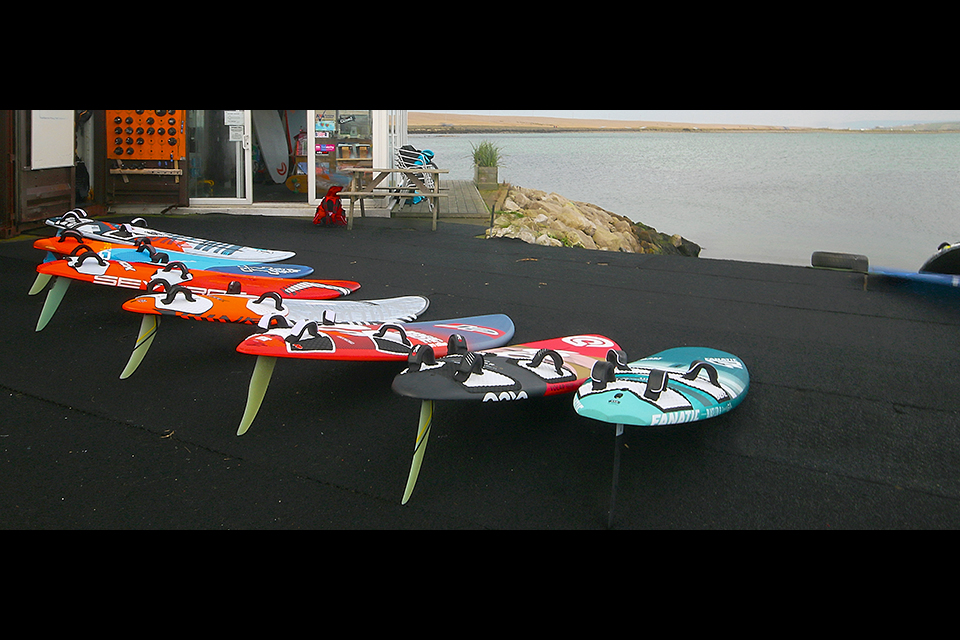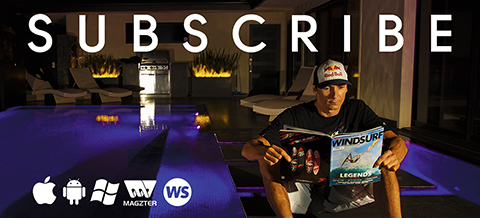RACE YA!
115L FREERIDE BLASTING BOARD TEST 2018
Test Editor Tris Best // Second Testers Maurin Rottenwalter & Joe North
Photos Tris Best // Test location Portland Harbour
There is one sensation in windsurfing above all others that we’ve all experienced and keeps us captivated, coming back for more. No matter how experienced you are, how many freestyle stunts you can spin through or loops you’ve rotated around, if you haven’t been on the water for a while, the fire inside you for windsurfing is instantly rekindled as soon as you experience it again. And that sensation is blasting. As soon as a gust hits the sail and its energy is channelled into the board, as soon as you shift back into the straps and push the board clear of the water, everything else that is going on in your life is forgotten. You are in a state of utopian bliss. It is precisely why the RYA evolved their teaching syllabus back in 2006 to include the Fast Forward formula from intermediate level onwards. The notion being that if they can teach and progress students as quickly as possible so that they experience the planing sensation early enough in their windsurfing pathway, then you’ll have them hooked and they’ll never leave the sport again. Over simplifying the million dollar question of how to grow the sport once again perhaps, but the idea certainly had merit. The feeling of skimming over the water, the board dancing over the crests of waves and fizzing with life simply can’t be beaten.
This test was originally published in the March 2018 issue.
FINDINGS
So here we are – 2018 and the latest batch of fast freeride contenders. There have been countless developments in the freeride sector over the years since its inception. In fact, the discipline itself was established back in the mid-nineties to highlight the fact that the consumer market demand was very different to that of the pro. Concepts have been and gone, some more successful than others, to help mould the modern freeride hull. This year sees a continuation of the wide-thin principal for many, initiated by Starboard in the Atom IQ, yet championed and fully exploited by the RRD Firemove, both of which have descendants in this year’s line-up. There’s the latest compact/stubby design idea represented in the Fanatic Blast – a theory taken from other sports and introduced to windsurfing by various brands three seasons ago. With their short lengths, parallel rails and low rocker, a compact outline may not get everyone’s juices flowing, but their credentials can’t be doubted and we’re sure that we’ll see much more ‘stubby’ influenced designs emerging in all windsurfing disciplines in the future.
But let’s take a step back for a moment and try to summarise the design brief for this style of board. Firstly they need to be easy to use – they need to plane early, accelerate smoothly and reach a good speed with relatively little technical input from the rider. Performance must come easy with them. Covering distance easily and comfortably, they should have a good wind range and retain their manners at all times without feeling dull or lifeless underfoot. And when it comes to the end of the run, the fast freeride hull needs to gybe as if it’s on rails. It needs to use all its speed in a constructive manner, entering the gybe effortlessly without intimidating the rider and guiding them through the turn as if on autopilot. And yet, if the rider wants to get involved, the board must respond willingly, providing enough measured feedback to inspire the sailor to push harder. It’s a tall order isn’t it … but one fulfilled admirably by the boards here to varying degrees.
Designing a board where performance comes easy is a bit like walking a tightrope between the extremes of too demanding and too ‘Noddy’. It is down to a brand’s designer and his test team as to which camp they are going to fall … but ultimately the goal is to design a board that is a match for its peers whilst requiring little input from the rider. A handy little measurement that gives us a glimpse as to what the riding style of the board will be is the distance from the back of the fin box to the back of the board. It is only a very rough guide, but as an example the distance on a modern slalom board may be anything from 8.0 cm to 8.7 cm, whereas in a wave board it could be as much as 13.5 cm. The further back the box, the more directional the ride, the board lifting out of the water and reducing its wetted area. The riding sensation will be electric and involving, the rider feeling that they have a direct connection with the fin. Shift the fin box forward and you increase the water length of the board, thereby increasing control and ease in carving manoeuvres. It is quite a precise art, a millimetre making a massive difference. As we mentioned before, it is only a very rough guide as it is one of many many factors that determine a board’s character, but using the principal for this test, the board with the smallest distance (8.3 cm – slalom board territory) is the Starboard Carve IQ – one of the more alert and involving boards in the group … and the board with the largest measurement is the RRD Firemove at 9.8 cm – one of the more manoeuvre-oriented and controllable boards in this test. It is up to you which way you want to go – easy, controllable and passive in nature, or more lively and alert, demanding input from the rider to really keep them on the straight and narrow.
SUMMARY
All bar one of the seven boards on test here have been influenced by the wide-thin style movement … and that board is the Blast from Fanatic. An advocate for an altogether different concept and one that is fast becoming proven as much more than simply a fad. Feeling conventional underfoot despite its unconventional dimensions, it simply works in both directional performance and around the corners. The most slalom-esque board in the group is the Severne Fox, supplied with a quality upright fin and a unique bottom shape that seems to iron out a lot of the control issues a slalom thoroughbred would have when the conditions turn on. The Tabou Rocket Wide also has a complex bottom shape and an ability to turn it on very similar to a freerace board at the very least. It is flighty and alive underfoot and really craves guidance from the pilot, but is easy to handle and calm down should you feel it getting away from you. The Volar from Goya is at the other end of the scale, so smooth and stable, it almost sails itself, taking the rider along for a ride as the passenger. It is a wonderful tutor for the progressing rider, yet has a good turn of speed if really pressed. The RRD Firemove and JP Magic Ride are both similar in riding style, both super capable in manoeuvres and inspiring in the gybe in particular. Their biggest difference is that the RRD is incredible in marginal winds, planing super early and accelerating quickly, whereas the JP really come alive in powered to overpowered conditions, particularly off the wind. That leaves the Starboard Carve IQ – the board that took the most getting used to in the test group. Easily the widest … and the shortest, it has a unique feel, but spend time on it and you begin to realise just how potent it can be. The freeride sector of the sport is very much alive and kicking and this test group is living proof of that.
THE LINE UP
• STARBOARD CARVE IQ 114 L.C.F.
TEST OVERVIEW PAGE


